Enhancing heritage architecture
Our approach to the lighting design of the heritage architecture involved a meticulous integration of modern techniques while complimenting the existing structure. Working through the original lighting drawings and details supplied by Seidler Architects, we relit the site using new technology and lens cross aiming the beams to highlight the underside of the icons. We also used different approaches for the heritage elements compared to the new artworks. We lit the heritage elements using 3000k temperature lights, and we lit the existing sculptures using a single source for greater visual impact. We chose 4000k lights for the new artworks as this brings out the colours of the mosaic wall.
The glass ribbon, featuring a subtle movement resembling fabric in the wind, required careful lighting considerations. Dynamic lighting was essential for the ribbon effect, allowing for dimming and brightening to simulate movement. We embedded lights into the façade rather than lighting from below to create a captivating glowing effect. The complex glass structure, with layers and patterns, demanded precision in light placement to achieve the desired ribbon effect.
This innovative use of lighting not only transforms the heritage architecture but also showcases a harmonious blend of traditional and contemporary elements, creating a visually stunning and dynamic nighttime aesthetic.









